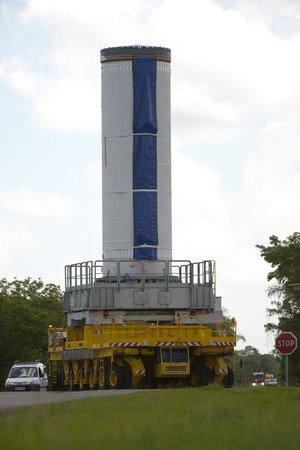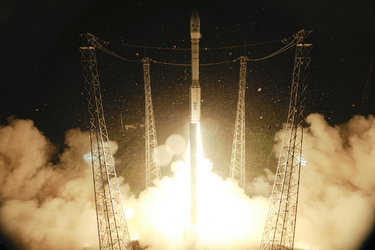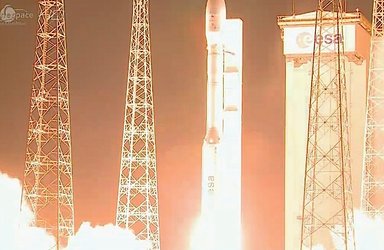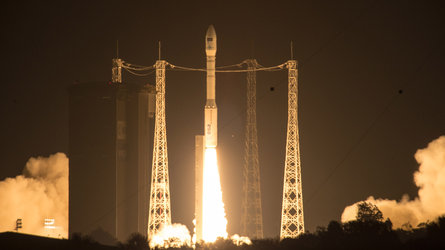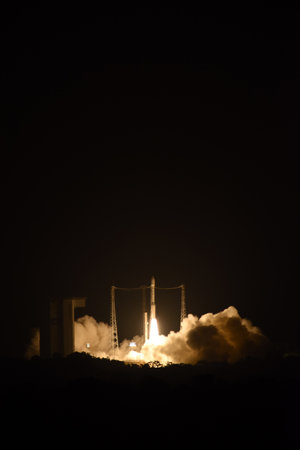Frequently asked questions on Vega
What is Vega?
Vega is Europe’s preferred launch system for lofting small 300–2000 kg scientific and Earth observation payloads into a wide range of low orbits from equatorial to polar. It leverages low-cost technologies and synergies with other European rocket systems to ensure quick, easy and inexpensive access to space. And unlike most small launchers, it has a multiple payload capability.
What does the name stand for?
Vega stands for Vettore Europeo di Generazione Avanzata (Advanced Generation European Vehicle). The acronym refers to Alpha Lyrae, one of the brightest stars visible in Europe’s skies and part of the prominent “Summer Triangle,” which appears at the zenith during clear summer evenings. Its name comes from the Arabic “an-nasr al waqi” (“attacking eagle”) and was used auspiciously for a pair of highly successful Soviet probes to Venus and the Halley comet.
What does the vehicle look like?
Vega is a single-body four-stage launcher with three solid-propellant stages and a restartable liquid-propellant upper stage, known as the Attitude and Venier Upper Module (AVUM), for attitude and orbit control and satellite release.
Who operates Vega?
The Operator for the Qualification Flight as well as per Verta Flights is ESA.
Commercial flights are operated by Arianespace, which holds exclusive rights to market and sell launch services.
Who are the contractors?
Vega is built by ELV, a joint venture of Italian Space Agency ASI and Avio. Avio is the Prime Contractor for the Launcher System. The first stage solid rocket motor is supplied by Europropulsion, a joint venture of Avio and Safran/Herakles; the second and third stage solid rocket motors are supplied by Avio; the AVUM (fourth stage) propulsion system, by Yuzhnoe/Yuzhmash of Ukraine; and hardware and software for AVUM and the interstages, by Airbus. SABCA produces the thrust vector controls for all stages and RUAG, the payload fairing. Vitrociset is prime contractor for the Vega ground segment in Kourou.
What is ESA’s role in Vega?
ESA was responsible for the Vega launch system development and purchases a certain number of flights for its own use and the needs of its Member States through the VERTA programme. The Agency supplies financing, technical and political support for exploitation support and for development, along with technical supervision based on its 30 years of experience with other rockets of the Ariane family. Together with participating Member States, it also provides a formal basis for integrating Vega into the European space transportation fleet, accessing the institutional market and ensuring the rocket’s long-term success in the marketplace. ESA heads the integrated Vega programme team and owns the Vega launch complex (ZLV).
Which Member States are behind the programme?
The Vega development programme was supported by seven ESA Member States, led by Italy. Belgium, France, Netherlands, Spain, Sweden and Switzerland are also funding the effort.
The same ESA Member States also support the VERTA Programme, which includes the VERTA Fights (like IXV) to enlarge the launch system qualified domain, and the Vega part of the LEAP Programme, for the more typical activities to accompany the exploitation.
New developments for Vega are now approved in the frame of the VECEP Programme, which is supported by the seven Member States above and also by Germany.
What technical changes or improvements have been made since the qualification launch?
The second flight (VV02) included a new Vespa payload adapter, to permit the mission to accommodate a multiple payload, new flight software developed and qualified in Italy and an additional tracking station in French Guiana. Proba-V was the first Vega payload to be released into a Sun-synchronous polar orbit (820 km altitude, inclination 98.73°). In addition to Proba-V and VNREDsat-1A, the mission also included an Estonian technology demonstrator, ESTCube-1.
The very complex mission included also for the demonstration of the fourth stage deorbit capability as required by applicable international agreements.
Are other space agencies involved in the programme?
During the Vega development phase major support was provided by the National Agencies of both main contributing countries:
- ASI contributed with technical staff to the integrated Vega programme team located at ESA’s ESRIN facility in Frascati, near Rome, and developed the demonstrator (Zefiro 16) on which the Zefiro first and second solid stages are based. It is to be noted that ASI also owns 30% of prime contractor ELV SpA.
-
French space agency CNES managed the qualification of the P80FW solid rocket motor, under ESA’s supervision, and also contributed significantly to the integrated Vega programme team with integrated staff as well as with technical support.
CNES also supported the combined test and launch campaigns where it covered the role of test responsible. CNES is finally also contractor for all development activities to adapt the Launch Range facilities and tools for Vega.
TECHNOLOGY
What are Vega's dimensions?
Vega stands 30 meters tall, with a diameter of 3 meters, and weighs 138 tons at liftoff.
Are the solid stages identical?
No. The first stage, designated P80FW, burns 88 tonnes of propellant; the second stage, Zefiro 23, 23.9 tonnes; and the third stage, Zefiro 9, 10 tonnes. P80FW is the largest monolithic (one-piece) carbon fibre solid-propellant motor in the industry, and Zefiro 9, the most efficient solid propulsion motor from a performance point of view.
What does P80FW stand for?
France, which led design of the P80FW, typically designates a rocket stage by its type of propellant (P for solid, L for liquid, H for cryogenic) followed by the total mass of its propellant load. Thus the designation P80 signifies a solid stage with 80 tonnes of propellant.
The suffix FW stands for ”filament wound,” indicating that the stage has a composite casing instead of the metal construction derived from the design on the earlier Ariane 5 EAP.
The P80FW derives from the design for the P85, the motor initially proposed based on the Ariane 5 EAP booster segment. As a result, the P80FW has the same diameter but uses an improved solid propellant with an innovative loading shape called finocyl.
Where is the P80FW manufactured?
The P80FW insulated motor case, which includes the structure of the motor together with its thermal protection, is produced by Avio in Colleferro, Italy, near Rome, and delivered to the Guiana Propellant Plant (UPG) in Kourou, where it is loaded with solid propellant. The stage is then transferred to the Booster Integration Building (BIP), where it is mated with the nozzle, produced by Safran/Herakles at the Booster Noozle Plant (UTB) in Le Haillan, near Bordeaux. The thrust vector control subsystem, including the actuator and the electronic control and power units, is manufactured by SABCA in Brussels. The igniter is built by APP in the Netherlands using composite technology.
How is the loaded P80FW moved from the Guiana Propellant Plant to the launch pad, and does this involve significant risk?
The stage is moved by road on the same vehicle that is used to move Ariane 5 booster segments from the propellant plant to the integration facility. The transfer is done smoothly and involves no risk at all for the propellant load.
Are the Zefiro second and third stage solid motors related to the PAP?
The relationship is very limited. The PAP was a small motor with a metallic structure and a fixed nozzle, whereas the Zefiro is a thrust vectored motor with a composite casing and a steerable nozzle. The two approaches are completely different.
Why aren’t the Zefiro solid stages loaded in French Guiana like the P80FW?
The smaller size of the Zefiro stages enables them to receive their propellant load in Colleferro and to be shipped fully loaded to French Guiana. This is similar to the procedure for upper stage segments on the Ariane 5, and to date more than 130 segments have been safely transferred this way.
Does the AVUM liquid upper stage have the capacity to deorbit at the end of its mission to limit the dissemination of launch debris?
Yes. This capability was demonstrated on the first VERTA Flight (VV02).
Was Vega designed for reduced environmental impact?
Preserving the environment is always one of ESA’s main concerns, and detailed environmental impact studies are carried out to ensure that every possible step is taken to minimise the potential consequences of operating launchers, including Vega, during each phase of their mission.
Vega is as clean as it can be with current technology, which means that its environmental impact is very limited. Even more environmentally friendly technologies are in development but they are not yet mature for implementation on an operational vehicle.
VERTA PROGRAMME
What is VERTA?
VERTA short for Vega Research, Technology & Accompaniment, is a programme set up to support and secure initial operation of the Vega launch system.
The programme includes:
A) The procurement of five Vega launches in support of ESA missions to ensure an initial launch rate of at least two flights per year.
B) The development of complementary services and hardware, such as a multiple-payload launch capacity and new payload adaptors tailored for Vega’s specific markets.
C) A framework for component testing and development to mitigate production risk and obsolescence. In this capacity, VERTA is the equivalent of Ariane 5’s ARTA-5 (Ariane Research, Technology & Accompaniment) programme.
Since the 2012 Council at Ministerial Level B) and C) are part of the Launchers Exploitation Accompaniment Programme (LEAP).
How many Vega launchers are in production for VERTA?
Five Vega vehicles were ordered under the VERTA programme, in addition to the rocket used in the qualification flight.
Are all Vega launchers dedicated to VERTA Flights?
Out of the five launchers produced under VERTA, three are VERTA Flights (operated by ESA: VV02 for PROBA V, VV04 for IXV, VV06 for LPF). The other two were for commercial launches operated by Arianespace.
Will IXV involve a VERTA launch?
Yes. It is the second VERTA launch and uses the third VERTA launcher.
OPERATIONS AND MARKET
Where are the Vega launch facilities located?
The Vega launch pad, designated ZLV, occupies the former ELA-1 launch zone originally used for the Ariane 1 and 3 rockets. Launcher preparation takes place on the pad, which is equipped with a 50 metre high 1,000 ton gantry for assembly, checkout and protection of launch personnel. Payload preparation and launch control are handled in facilities built for the Ariane 5.
FUTURE DEVELOPMENTS
Are additional Vega upgrades planned?
At the ESA Council at Ministerial level on 2 December 2014, funds were approved for development of an upgraded design, known as Vega-C (for Consolidated), that increased performance of this light-lift vehicle and optimises synergies with other European rockets. A new P120C motor is used as the first stage on Vega-C while two or four of these motors are used as boosters for the Ariane 6 heavy launcher. Vega-C made its inaugural flight on 13 July 2022.















 Germany
Germany
 Austria
Austria
 Belgium
Belgium
 Denmark
Denmark
 Spain
Spain
 Estonia
Estonia
 Finland
Finland
 France
France
 Greece
Greece
 Hungary
Hungary
 Ireland
Ireland
 Italy
Italy
 Luxembourg
Luxembourg
 Norway
Norway
 The Netherlands
The Netherlands
 Poland
Poland
 Portugal
Portugal
 Czechia
Czechia
 Romania
Romania
 United Kingdom
United Kingdom
 Slovenia
Slovenia
 Sweden
Sweden
 Switzerland
Switzerland






























